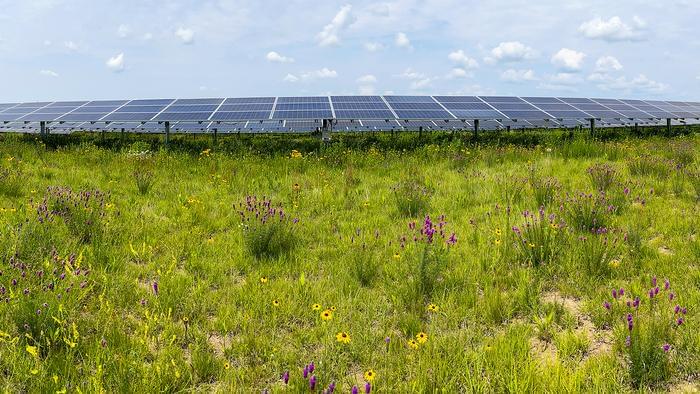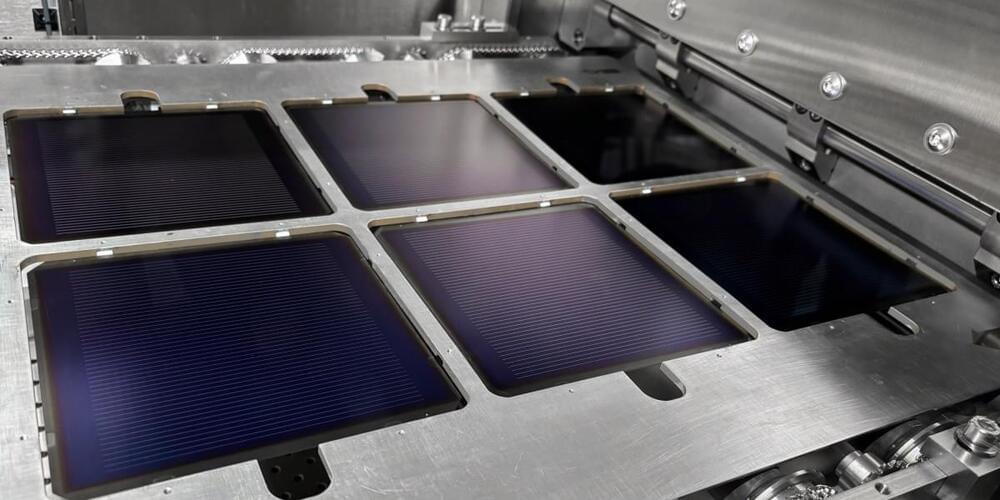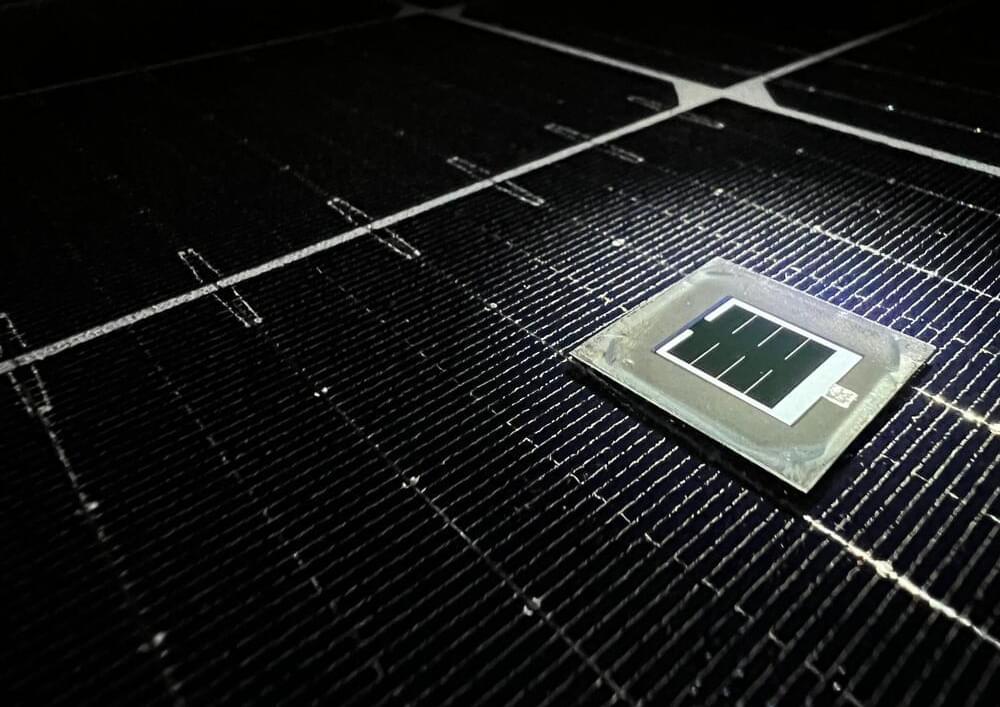Caltech’s Space Solar Power Demonstrator (SSPD-1) was launched into space one year ago.
After nearly a year in orbit, Caltech’s Space Solar Power Demonstrator (SSPD-1) reached its end of mission.
Caltech’s Space Solar Power Demonstrator (SSPD-1) was launched into space one year ago.
After nearly a year in orbit, Caltech’s Space Solar Power Demonstrator (SSPD-1) reached its end of mission.

“This research highlights the relatively rapid insect community responses to habitat restoration at solar energy sites,” said Leroy Walston.
How could solar energy facilities contribute to insect populations? This is what a recent study published in Environmental Research hopes to address as a team of researchers investigated how insect and plant populations in re-established habitats comprised of wildflowers and native grasses changed during a five-year period in the vicinity of photovoltaic (PV) solar array parks. This study holds the potential to help scientists, engineers, and conservationists gain greater insight into the ecological impact of solar farms on newly planted vegetation.
For the study, the researchers surveyed two solar sites located approximately 100 miles (160 km) apart in southern Minnesota, Eastwood Solar Site and Atwater Solar Site, between 2018 and 2022 for changes in insect and plant populations on restored land with native forbs and grasses. After conducting 358 observations of across sites, the researchers found increases in the biodiversity of both sites, including plant species and total insect abundance.

Solar energy is traditionally known for using massive solar panels that collect sunlight and convert it into clean energy, but what if this same energy was instead beamed from satellites in orbit around the Earth, known as space solar power? This is the goal of Space Solar Power Demonstrator (SSPD-1), which is a 110-pound (50-kilogram) project run by the California Institute of Technology (Caltech). SSPD-1 was launched onboard the SpaceX Transporter-6 mission on January 3, 2023, and recently concluded its mission after conducting a series of experiments, including the ability to wirelessly beam solar power from space to Earth, which it accomplished in early 2023.
“Solar power beamed from space at commercial rates, lighting the globe, is still a future prospect. But this critical mission demonstrated that it should be an achievable future,” said Dr. Thomas F. Rosenbaum, who is the President of Caltech and the Sonja and William Davidow Presidential Chair and professor of physics.
SSPD-1 successfully demonstrated three experiments during its one-year mission: DOLCE (Deployable on-Orbit ultraLight Composite Experiment), ALBA, and MAPLE (Microwave Array for Power-transfer Low-orbit Experiment). DOLCE demonstrated the architecture necessary for developing space solar power, ALBA demonstrated how to harness solar energy in space, and MAPLE demonstrated how this energy could be wirelessly beamed to Earth.
New advancements in technology frequently necessitate the development of novel materials – and thanks to supercomputers and advanced simulations, researchers can bypass the time-consuming and often inefficient process of trial-and-error.
The Materials Project, an open-access database founded at the Department of Energy’s Lawrence Berkeley National Laboratory (Berkeley Lab) in 2011, computes the properties of both known and predicted materials. Researchers can focus on promising materials for future technologies – think lighter alloys that improve fuel economy in cars, more efficient solar cells to boost renewable energy, or faster transistors for the next generation of computers.


Artificial intelligence can accelerate the process of finding and testing new materials, and now researchers have used that ability to develop a battery that is less dependent on the costly mineral lithium.
Lithium-ion batteries power many devices that we use every day as well as electric vehicles. They would also be a necessary part of a green electric grid, as batteries are required to store renewable energy from wind turbines and solar panels. But lithium is expensive and mining it damages the environment. Finding a replacement for this crucial metal could be costly and time-consuming, requiring researchers to develop and test millions of candidates over the course of years. Using AI, Nathan Baker at Microsoft and his colleagues accomplished the task in months. They designed and built a battery that uses up to 70 per cent less lithium than some competing designs.

Scientists have unveiled a roadmap for bringing perovskite/silicon tandem solar cells to market, paving the way for a future powered by abundant, inexpensive clean energy in Saudi Arabia and the world.
The authors of the article, published in Science, include Prof. Stefaan De Wolf and his research team at King Abdullah University of Science (KAUST) and Technology Solar Center. The team is working on improving solar efficiency to meet Saudi Arabia’ solar targets.
Perovskite/silicon tandem technology combines the strengths of two materials— perovskite’s efficient light absorption and silicon’s long-term stability—to achieve record-breaking efficiency. In 2023, the De Wolf laboratory reported two world records for power conversion efficiency, with five achieved globally in the same year, showing rapid progress in perovskite/silicon tandem technology.
University of Michigan researchers have found that large additives could be the secret to making stable and long-lasting perovskite solar cells.
Researchers from the University of Michigan have found that large additives appear to prevent perovskite semiconductors from degrading quickly.
Zero-emissions long-distance aviation is absolutely possible… Provided you’re not in a hurry. Solar Airship One will take 20 days to fly all the way around the equator, some 40,000 km (~25,000 miles), in a single zero-emissions hop.
The 151-m (495-ft)-long airship will have its entire upper surface covered in solar film – some 4,800 square meters (51,700 sq ft) of it, or about nine-tenths of an NFL football field for those of you who prefer the standard units.
By day, the solar panels will run the airship’s electric propulsion systems, while also banking up extra power for the overnight haul by electrolyzing water into hydrogen. By night, the hydrogen will run through a fuel cell, providing the juice to keep going.

Solar panels are already an affordable energy solution since they generate enough power over their lifetimes to pay for themselves and then some. However, they do take some investment up front, and some people (and homeowners associations) dislike the way they look.
So what if you could get that power to make electricity from sunlight without having to install solar panels? That’s the beauty of solar paint, as reported by Solar Action Alliance.
The idea behind solar paint (aka photovoltaic paint) is simple: It’d be like ordinary paint but with billions of light-sensitive particles mixed in, as Understand Solar notes.